Cisco Firepower Threat Defense for the ASA 5512-X, ASA 5515-X, ASA 5525-X, ASA 5545-X, and ASA 5555-X Using Firepower Device Manager Quick Start Guide
Available Languages
Table of Contents
4. Deploy the Firepower Threat Defense in Your Network
5. Power on the Firepower Threat Defense Device
6. Launch Firepower Device Manager
7. How to Configure the Device in Firepower Device Manager
Cisco Firepower Threat Defense for the ASA 5512-X, ASA 5515-X, ASA 5525-X, ASA 5545-X, and ASA 5555-X Using Firepower Device Manager Quick Start Guide
First Published: August 10, 2016
Last Updated: November 2, 2020
Note![]() : You cannot install Firepower Threat Defense 6.7 or subsequent releases on the ASA 5515-X, 5525-X, 5545-X, and 5555-X. The final supported Firepower Threat Defense release for these platforms is 6.6.0
: You cannot install Firepower Threat Defense 6.7 or subsequent releases on the ASA 5515-X, 5525-X, 5545-X, and 5555-X. The final supported Firepower Threat Defense release for these platforms is 6.6.0
Note![]() : You cannot install Firepower Threat Defense 6.3 or subsequent releases on the ASA 5512-X. The final supported Firepower Threat Defense release for this platforms is 6.2.3.
: You cannot install Firepower Threat Defense 6.3 or subsequent releases on the ASA 5512-X. The final supported Firepower Threat Defense release for this platforms is 6.2.3.
1. Is This Guide for You?
This guide explains how to complete the initial configuration of your Firepower Threat Defense device using the Firepower Device Manager web-based device setup wizard included on Firepower Threat Defense devices.
Firepower Device Manager lets you configure the basic features of the software that are most commonly used for small networks. It is especially designed for networks that include a single device or just a few, where you do not want to use a high-powered multiple-device manager to control a large network containing many Firepower Threat Defense devices.
If you are managing large numbers of devices, or if you want to use the more complex features and configurations that Firepower Threat Defense allows, use the Firepower Management Center to configure your devices instead of the integrated Firepower Device Manager.
Use the CLI setup wizard to configure your Firepower Threat Defense device for network connectivity and to register the device to a Firepower Management Center as described in http://www.cisco.com/go/ftd-asa-quick.
3. License Requirements
Firepower Threat Defense devices require Cisco Smart Licensing. Smart Licensing lets you purchase and manage a pool of licenses centrally. Unlike product authorization key (PAK) licenses, Smart Licenses are not tied to a specific serial number or license key. Smart Licensing lets you assess your license usage and needs at a glance.
In addition, Smart Licensing does not prevent you from using product features that you have not yet purchased. You can start using a license immediately, as long as you are registered with the Cisco Smart Software Manager, and purchase the license later. This allows you to deploy and use a feature, and avoid delays due to purchase order approval.
When you purchase one or more Smart Licenses for Firepower features, you manage them in the Cisco Smart Software Manager: http://www.cisco.com/web/ordering/smart-software-manager/index.html. The Smart Software Manager lets you create a master account for your organization. For more information about the Cisco Smart Software Manager, see the Cisco Smart Software Manager User Guide.
Your purchase of a Firepower Threat Defense device or Firepower Threat Defense Virtual automatically includes a Base license. All additional licenses (Threat, Malware, or URL Filtering) are optional. For more information about Firepower Threat Defense licensing, see the Licensing the System chapter of the Cisco Firepower Threat Defense Configuration Guide for Firepower Device Manager.
4. Deploy the Firepower Threat Defense in Your Network
The following figure shows the recommended network deployment for Firepower Threat Defense on the ASA 5512-X, ASA 5515-X, ASA 5525-X, ASA 5545-X, and ASA 5555-X.

The example configuration enables the above network deployment with the following behavior.
- inside --> outside traffic flow
- outside IP address from DHCP
- DHCP for clients on inside. There is a DHCP server on the inside interface. You can plug your management computer directly into one of the inside interfaces and get an address on the 192.168.1.0/24 network.
HTTPS access is enabled on the inside interface, so you can open Firepower Device Manager through the inside interface at the default address, 192.168.1.1.
- Alternatively, you can connect to Management 0/0 to set up and manage the device using the Firepower Device Manager. There is a DHCP server on the management interface. You can plug your management computer directly into this interface and get an address on the 192.168.45.0/24 network.
HTTPS access is enabled on the management interface, so you can open Firepower Device Manager through the management interface at the default address, 192.168.45.45.
Note![]() : The physical management interface is shared between the Management logical interface and the Diagnostic logical interface; see the Interfaces chapter of the Firepower Threat Defense Configuration Guide for Firepower Device Manager.
: The physical management interface is shared between the Management logical interface and the Diagnostic logical interface; see the Interfaces chapter of the Firepower Threat Defense Configuration Guide for Firepower Device Manager.
- The Firepower Threat Defense system requires Internet access for licensing and updates. The default gateway for the management IP address is to use the data interfaces to route to the Internet. Thus, you do not need to wire the Management physical interface to a network.
Connect the Interfaces
The default configuration assumes that certain interfaces are used for the inside and outside networks. Initial configuration will be easier to complete if you connect network cables to the interfaces based on these expectations. To cable the above scenario on the ASA 5512-X, 5515-X, 5525-X, 5545-X, and 5555-X, see the following illustration.
Note![]() : The following illustration shows a simple topology using a management computer connected to the inside network. Other topologies can be used and your deployment will vary depending on your basic logical network connectivity, ports, addressing, and configuration requirements.
: The following illustration shows a simple topology using a management computer connected to the inside network. Other topologies can be used and your deployment will vary depending on your basic logical network connectivity, ports, addressing, and configuration requirements.
Figure 1 ASA 5512-X, 5515-X, 5525-X, 5545-X, and 5555-X

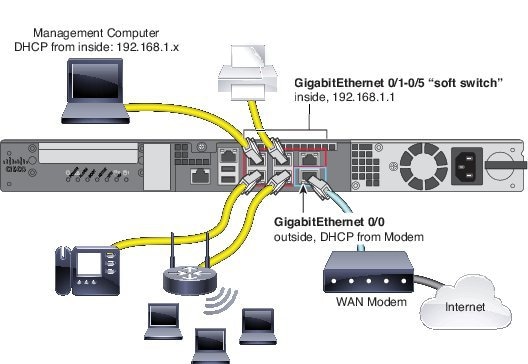
1.![]() Connect the GigabitEthernet 0/0 (outside) interface to your ISP/WAN modem or other outside device. By default, the IP address is obtained using DHCP, but you can set a static address during initial configuration.
Connect the GigabitEthernet 0/0 (outside) interface to your ISP/WAN modem or other outside device. By default, the IP address is obtained using DHCP, but you can set a static address during initial configuration.
2.![]() Connect a local management workstation, the one you will use to configure the device, to the inside interface GigabitEthernet 0/1.
Connect a local management workstation, the one you will use to configure the device, to the inside interface GigabitEthernet 0/1.
3.![]() Configure the workstation to obtain an IP address using DHCP. The workstation gets an address on the 192.168.1.0/24 network.
Configure the workstation to obtain an IP address using DHCP. The workstation gets an address on the 192.168.1.0/24 network.
Note![]() : You have a couple of other options for connecting the management workstation. You can also directly connect it to the Management port. The workstation gets an address through DHCP on the 192.168.45.0/24 network. Another option is to leave your workstation attached to a switch, and attach that switch to GigabitEthernet 0/1. However, you must ensure that no other device on the switch's network is running a DHCP server, because it will conflict with the one running on the inside interface, 192.168.1.1.
: You have a couple of other options for connecting the management workstation. You can also directly connect it to the Management port. The workstation gets an address through DHCP on the 192.168.45.0/24 network. Another option is to leave your workstation attached to a switch, and attach that switch to GigabitEthernet 0/1. However, you must ensure that no other device on the switch's network is running a DHCP server, because it will conflict with the one running on the inside interface, 192.168.1.1.
5. Power on the Firepower Threat Defense Device
1.![]() Attach the power cable to the Firepower Threat Defense device and connect it to an electrical outlet.
Attach the power cable to the Firepower Threat Defense device and connect it to an electrical outlet.
The power turns on automatically when you plug in the power cable; do not press the power button on the front panel. (For older models, the power does not turn on automatically; check the hardware installation guide for more information).
2.![]() Check the Power LED on the front of the Firepower Threat Defense device; if it is solid green, the device is powered on.
Check the Power LED on the front of the Firepower Threat Defense device; if it is solid green, the device is powered on.
3.![]() Check the Status LED on the front of the Firepower Threat Defense device; after it is solid green, the system has passed power-on diagnostics.
Check the Status LED on the front of the Firepower Threat Defense device; after it is solid green, the system has passed power-on diagnostics.
6. Launch Firepower Device Manager
When you initially log into Firepower Device Manager, you are taken through the device setup wizard to complete the initial system configuration.
Ensure that you connect a data interface to your gateway device, for example, a cable modem or router. For edge deployments, this would be your Internet-facing gateway. For data center deployments, this would be a back-bone router. Use the default “outside” interface identified in 4. Deploy the Firepower Threat Defense in Your Network.
1.![]() Open a browser and log into Firepower Device Manager. Assuming you did not go through initial configuration in the CLI, open Firepower Device Manager at https: //ip-address, where the address is one of the following:
Open a browser and log into Firepower Device Manager. Assuming you did not go through initial configuration in the CLI, open Firepower Device Manager at https: //ip-address, where the address is one of the following:
–![]() If you are connected to the inside interface: https://192.168.1.1.
If you are connected to the inside interface: https://192.168.1.1.
–![]() If you are connected to the Management physical interface: https://192.168.45.45.
If you are connected to the Management physical interface: https://192.168.45.45.
2.![]() Log in with the username admin, password Admin123.
Log in with the username admin, password Admin123.
3.![]() If this is the first time logging into the system, and you did not use the CLI setup wizard, you are prompted to read and accept the End User License Agreement and change the admin password. You must complete these steps to continue.
If this is the first time logging into the system, and you did not use the CLI setup wizard, you are prompted to read and accept the End User License Agreement and change the admin password. You must complete these steps to continue.
4.![]() Configure the following options for the outside and management interfaces and click Next.
Configure the following options for the outside and management interfaces and click Next.
Note![]() : Your settings are deployed to the device when you click Next. The interface will be named “outside” and it will be added to the “outside_zone” security zone. Ensure that your settings are correct.
: Your settings are deployed to the device when you click Next. The interface will be named “outside” and it will be added to the “outside_zone” security zone. Ensure that your settings are correct.
a.![]() Outside Interface —This is the data port that you connected to your gateway mode or router. You cannot select an alternative outside interface during initial device setup. The first data interface is the default outside interface.
Outside Interface —This is the data port that you connected to your gateway mode or router. You cannot select an alternative outside interface during initial device setup. The first data interface is the default outside interface.
Configure IPv4 —The IPv4 address for the outside interface. You can use DHCP or manually enter a static IP address, subnet mask, and gateway. You can also select Off to not configure an IPv4 address.
Configure IPv6 —The IPv6 address for the outside interface. You can use DHCP or manually enter a static IP address, prefix, and gateway. You can also select Off to not configure an IPv6 address.
DNS Servers —The DNS server for the system's management address. Enter one or more addresses of DNS servers for name resolution. The default is the OpenDNS public DNS servers. If you edit the fields and want to return to the default, click Use OpenDNS to reload the appropriate IP addresses into the fields.
Firewall Hostname —The hostname for the system's management address.
Note![]() : When you configure the Firepower Threat Defense device using the device setup wizard, the system provides two default access rules for outbound and inbound traffic. You can go back and edit these access rules after initial setup.
: When you configure the Firepower Threat Defense device using the device setup wizard, the system provides two default access rules for outbound and inbound traffic. You can go back and edit these access rules after initial setup.
5.![]() Configure the system time settings and click Next.
Configure the system time settings and click Next.
a.![]() Time Zone —Select the time zone for the system.
Time Zone —Select the time zone for the system.
b.![]() NTP Time Server —Select whether to use the default NTP servers or to manually enter the addresses of your NTP servers. You can add multiple servers to provide backups.
NTP Time Server —Select whether to use the default NTP servers or to manually enter the addresses of your NTP servers. You can add multiple servers to provide backups.
6.![]() Configure the smart licenses for the system.
Configure the smart licenses for the system.
You must have a smart license account to obtain and apply the licenses that the system requires. Initially, you can use the 90-day evaluation license and set up smart licensing later.
To register the device now, click the link to log into your Smart Software Manager account, generate a new token, and copy the token into the edit box.
To use the evaluation license, select Start 90 day evaluation period without registration. To later register the device and obtain smart licenses, click the name of the device in the menu to get to the Device Dashboard, then click the link in the Smart Licenses group.
Once you complete the device setup wizard, a pop-up presents you with your next options to configure the device.
- If you connected other interfaces to networks, select Configure Interfaces to configure each of the connected interfaces.
- If you want to modify the default access rules, select Configure Policy to configure and manage traffic policies.
You can select either option, or dismiss the pop-up to return to the Device Dashboard.
7. How to Configure the Device in Firepower Device Manager
After you complete the setup wizard, you should have a functioning device with a few basic policies in place:
- (Except for ASA 5506-X.) An outside and an inside interface. No other data interfaces are configured.
- (ASA 5506-X only.) An outside interface, and an inside bridge group that includes all other data interfaces.
- Security zones for the inside and outside interfaces.
- An access rule trusting all inside to outside traffic.
- A interface NAT rule that translates all inside to outside traffic to unique ports on the IP address of the outside interface.
- A DHCP server running on the inside interface or bridge group.
The following steps provide an overview of additional features you might want to configure. Please click the help button (?) on a page to get detailed information about each step.
1.![]() Choose Device, then click View Configuration in the Smart License group.
Choose Device, then click View Configuration in the Smart License group.
Click Enable if you want to use the optional Threat license.
Note![]() : The ISA 3000 supports the Threat license only. It does not support the Malware or URL Filtering licenses. Thus, you cannot configure features that require the Malware or URL Filtering licenses on the ISA 3000.
: The ISA 3000 supports the Threat license only. It does not support the Malware or URL Filtering licenses. Thus, you cannot configure features that require the Malware or URL Filtering licenses on the ISA 3000.
If you have not registered, you can do so from this page. Click Request Register and follow the instructions. Please register before the evaluation license expires.
For example, an enabled Threat license should look like the following:
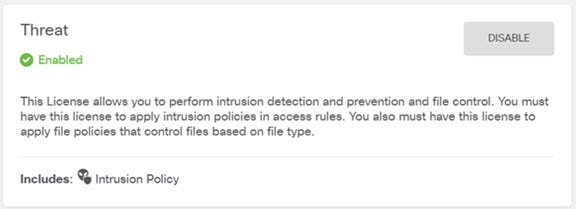
2.![]() If you wired other interfaces, choose Device, then click View Configuration in the Interfaces group and configure each wired interface.
If you wired other interfaces, choose Device, then click View Configuration in the Interfaces group and configure each wired interface.
The ASA 5506-X comes pre-configured with a bridge group containing all non-outside data interfaces, there is no need to configure these interfaces. However, if you want to break apart the bridge group, you can edit it to remove the interfaces you want to treat separately. Then you can configure those interfaces as hosting separate networks.
For other models, you can create a bridge group for the other interfaces, or configure separate networks, or some combination of both. Click the edit icon for each interface to define the IP address and other settings.
The following example configures an interface to be used as a “demilitarized zone” (DMZ), where you place publicly-accessible assets such as your web server. Click Save when you are finished.
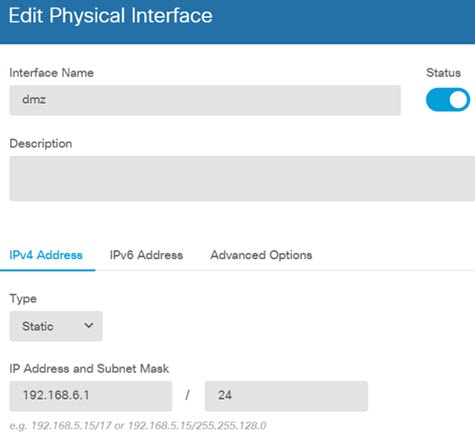
3.![]() If you configured new interfaces, choose Objects, then select Security Zones from the table of contents.
If you configured new interfaces, choose Objects, then select Security Zones from the table of contents.
Edit or create new zones as appropriate. Each interface must belong to a zone, because you configure policies based on security zones, not interfaces. You cannot put the interfaces in zones when configuring them, so you must always edit the zone objects after creating new interfaces or changing the purpose of existing interfaces.
The following example shows how to create a new dmz-zone for the dmz interface.
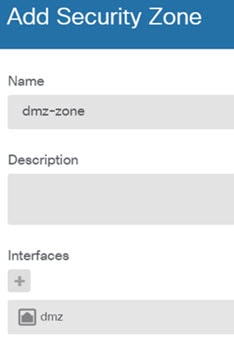
4.![]() If you want internal clients to use DHCP to obtain an IP address from the device, choose Device > System Settings > DHCP Server, then select the DHCP Servers tab.
If you want internal clients to use DHCP to obtain an IP address from the device, choose Device > System Settings > DHCP Server, then select the DHCP Servers tab.
There is already a DHCP server configured for the inside interface, but you can edit the address pool or even delete it. If you configured other inside interfaces, it is very typical to set up a DHCP server on those interfaces. Click + to configure the server and address pool for each inside interface.
You can also fine-tune the WINS and DNS list supplied to clients on the Configuration tab. The following example shows how to set up a DHCP server on the inside2 interface with the address pool 192.168.4.50-192.168.4.240.
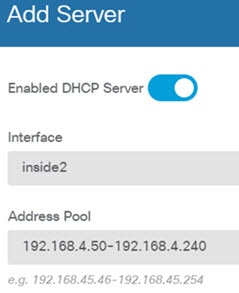
5.![]() Choose Device, then click View Configuration (or Create First Static Route) in the Routing group and configure a default route.
Choose Device, then click View Configuration (or Create First Static Route) in the Routing group and configure a default route.
The default route normally points to the upstream or ISP router that resides off the outside interface. A default IPv4 route is for any-ipv4 (0.0.0.0/0), whereas a default IPv6 route is for any-ipv6 (::0/0). Create routes for each IP version you use. If you use DHCP to obtain an address for the outside interface, you might already have the default routes that you need.
Note![]() : The routes you define on this page are for the data interfaces only. They do not impact the management interface. Set the management gateway on Device > System Settings > Management Interface.
: The routes you define on this page are for the data interfaces only. They do not impact the management interface. Set the management gateway on Device > System Settings > Management Interface.
The following example shows a default route for IPv4. In this example, isp-gateway is a network object that identifies the IP address of the ISP gateway (you must obtain the address from your ISP). You can create this object by clicking Create New Network at the bottom of the Gateway drop-down list.
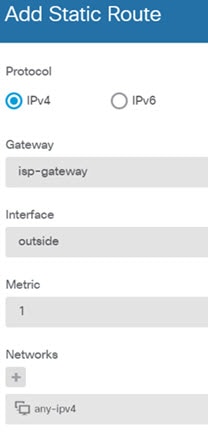
6.![]() Choose Policies and configure the security policies for the network.
Choose Policies and configure the security policies for the network.
The device setup wizard enables traffic flow between the inside-zone and outside-zone, and interface NAT for all interfaces when going to the outside interface. Even if you configure new interfaces, if you add them to the inside-zone object, the access control rule automatically applies to them.
However, if you have multiple inside interfaces, you need an access control rule to allow traffic flow from inside-zone to inside-zone. If you add other security zones, you need rules to allow traffic to and from those zones. These would be your minimum changes.
In addition, you can configure other policies to provide additional services, and fine-tune NAT and access rules to get the results that your organization requires. You can configure the following policies:
–![]() SSL Decryption —If you want to inspect encrypted connections (such as HTTPS) for intrusions, malware, or to enforce compliance with your URL and application usage polices, you must decrypt the connections. Use the SSL decryption policy to determine which connections need to be decrypted. The system re-encrypts the connection after inspecting it.
SSL Decryption —If you want to inspect encrypted connections (such as HTTPS) for intrusions, malware, or to enforce compliance with your URL and application usage polices, you must decrypt the connections. Use the SSL decryption policy to determine which connections need to be decrypted. The system re-encrypts the connection after inspecting it.
–![]() Identity —If you want to correlate network activity to individual users, or control network access based on user or user group membership, use the identity policy to determine the user associated with a given source IP address.
Identity —If you want to correlate network activity to individual users, or control network access based on user or user group membership, use the identity policy to determine the user associated with a given source IP address.
–![]() Security Intelligence —Use the Security Intelligence policy to quickly drop connections from or to blacklisted IP addresses or URLs. By blacklisting known bad sites, you do not need to account for them in your access control policy. Cisco provides regularly updated feeds of known bad addresses and URLs so that the Security Intelligence blacklist updates dynamically. Using feeds, you do not need to edit the policy to add or remove items in the blacklist.
Security Intelligence —Use the Security Intelligence policy to quickly drop connections from or to blacklisted IP addresses or URLs. By blacklisting known bad sites, you do not need to account for them in your access control policy. Cisco provides regularly updated feeds of known bad addresses and URLs so that the Security Intelligence blacklist updates dynamically. Using feeds, you do not need to edit the policy to add or remove items in the blacklist.
–![]() NAT (Network Address Translation)—Use the NAT policy to convert internal IP addresses to externally routeable addresses.
NAT (Network Address Translation)—Use the NAT policy to convert internal IP addresses to externally routeable addresses.
–![]() Access Control —Use the access control policy to determine which connections are allowed on the network. You can filter by security zone, IP address, protocol, port, application, URL, user or user group. You also apply intrusion and file (malware) policies using access control rules. Use this policy to implement URL filtering.
Access Control —Use the access control policy to determine which connections are allowed on the network. You can filter by security zone, IP address, protocol, port, application, URL, user or user group. You also apply intrusion and file (malware) policies using access control rules. Use this policy to implement URL filtering.
–![]() Intrusion —Use the intrusion policies to inspect for known threats. Although you apply intrusion policies using access control rules, you can edit the intrusion policies to selectively enable or disable specific intrusion rules.
Intrusion —Use the intrusion policies to inspect for known threats. Although you apply intrusion policies using access control rules, you can edit the intrusion policies to selectively enable or disable specific intrusion rules.
The following example shows how to allow traffic between the inside-zone and dmz-zone in the access control policy. In this example, no options are set on any of the other tabs except for Logging, where At End of Connection is selected.

7.![]() Choose Device, then click View Configuration in the Updates group and configure the update schedules for the system databases.
Choose Device, then click View Configuration in the Updates group and configure the update schedules for the system databases.
If you are using intrusion policies, set up regular updates for the Rules and VDB databases. If you use Security Intelligence feeds, set an update schedule for them. If you use geolocation in any security policies as matching criteria, set an update schedule for that database.
8.![]() Click the Deploy button in the menu, then click the Deploy Now button(
Click the Deploy button in the menu, then click the Deploy Now button( ), to deploy your changes to the device.
), to deploy your changes to the device.
8. Where to Go Next
- For more information about managing the Firepower Threat Defense with the Firepower Device Manager, see the Firepower Threat Defense configuration guide, or the Firepower Device Manager online help.
Cisco and the Cisco logo are trademarks or registered trademarks of Cisco and/or its affiliates in the U.S. and other countries. To view a list of Cisco trademarks, go to this URL: www.cisco.com/go/trademarks. Third-party trademarks mentioned are the property of their respective owners. The use of the word partner does not imply a partnership relationship between Cisco and any other company. (1721R)
Contact Cisco
- Open a Support Case

- (Requires a Cisco Service Contract)
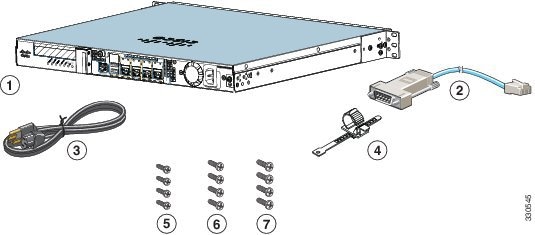
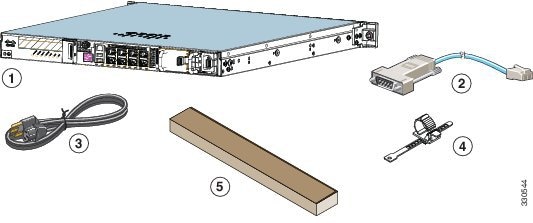
 Feedback
Feedback